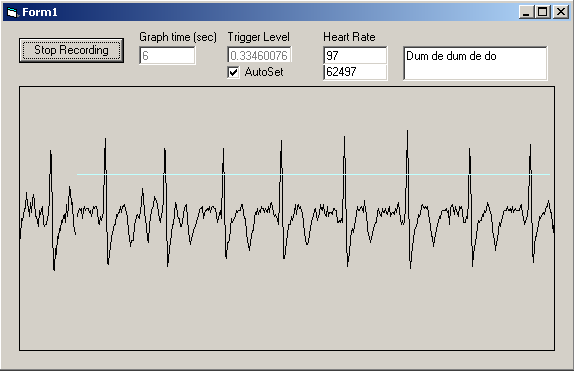Hi all,
My PICAXE experiments (and you lot) are helping me go from strength to strength with my electronics knowledge. I'd very much like to build a minimal PICAXE "simplest EEG" for neurofeedback purposes but I'm a bit out of my depth on this one.
I think that an EEG needs a preamp stage with gain of 10,000 to bring a signal to 1V PEP which means instrumentation op-amps are probably the correct way to go, although here is an ECG built using TL-082s. I don't know how well it would work with another order of magnitude to it's gain, although an alternate resistor value in the schematic does enable this.
I don't really need a traditional waveform view of the EEG data, or I'd look at a soundcard-interfaced FM/AM modulated solution (which would also let me do FFT etc in software for a pretty spectral view).
For simplicity (ever my goal), not to mention isolation, I want a self-contained battery-powered unit. The best solution would have four meters/LEDs indicating the relative strength of delta, theta, alpha and beta waves. I *think* I could do this with bandpass filters after the preamp.
However I'm trying to think simpler still and find the minimum required to visualise, in some form, amplified brain waves. For one thing I don't have any instrumentation op-amps! The absolute simplest solution I can think of is having an analogue meter responding directly to the preamp, with a band-pass filter to knock out everything not +/- 3Hz of 10Hz. As meter movements can be so sensitive, that might let me get away with a lower-gain input stage - possibly using an LM324? Of course, a moving meter may not be a lot of use for practical neurofeedback, but it would be a good start.
Is my "ghetto solution" plausible or am I way off the mark on this one? Is a good enough "alpha wave filter" easy to do?
OK, I admit, the PICAXE connection is currently tenuous but I promise I'll find a way to shoehorn one in there!
My PICAXE experiments (and you lot) are helping me go from strength to strength with my electronics knowledge. I'd very much like to build a minimal PICAXE "simplest EEG" for neurofeedback purposes but I'm a bit out of my depth on this one.
I think that an EEG needs a preamp stage with gain of 10,000 to bring a signal to 1V PEP which means instrumentation op-amps are probably the correct way to go, although here is an ECG built using TL-082s. I don't know how well it would work with another order of magnitude to it's gain, although an alternate resistor value in the schematic does enable this.
I don't really need a traditional waveform view of the EEG data, or I'd look at a soundcard-interfaced FM/AM modulated solution (which would also let me do FFT etc in software for a pretty spectral view).
For simplicity (ever my goal), not to mention isolation, I want a self-contained battery-powered unit. The best solution would have four meters/LEDs indicating the relative strength of delta, theta, alpha and beta waves. I *think* I could do this with bandpass filters after the preamp.
However I'm trying to think simpler still and find the minimum required to visualise, in some form, amplified brain waves. For one thing I don't have any instrumentation op-amps! The absolute simplest solution I can think of is having an analogue meter responding directly to the preamp, with a band-pass filter to knock out everything not +/- 3Hz of 10Hz. As meter movements can be so sensitive, that might let me get away with a lower-gain input stage - possibly using an LM324? Of course, a moving meter may not be a lot of use for practical neurofeedback, but it would be a good start.
Is my "ghetto solution" plausible or am I way off the mark on this one? Is a good enough "alpha wave filter" easy to do?
OK, I admit, the PICAXE connection is currently tenuous but I promise I'll find a way to shoehorn one in there!
Last edited:

